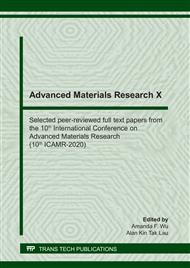p.3
p.8
p.13
p.18
p.24
p.31
p.36
p.41
Effects of Cutting Fluids on Surface Roughness in Single-Point Diamond Turning of Rapidly Solidified Aluminium (RSA 431)
Abstract:
Single-point diamond turning is a technique of ultra-high precision machining that provides excellent quality of surface for mirrors, spherical and aspherical components. In SPDT just like other machining processes, cutting fluid plays an important role in metal removal and tool condition which largely influence the surface of diamond turned surface. In this paper, the surface roughness of diamond turned RSA 431 was studied by investigating the effect of kerosene mist and water as cutting fluids. Higher order response surface of Box-Behnken design was generated using fewer runs than a normal factorial technique. The cutting parameters that were varied for both experiments were depth of cut, feed and, speed. Taylor Hobson PGI Dimension XL surface Profilometer was used to measure the surface roughness after each experimental run. The results show that water when used as cutting fluid during machining, produces better surface roughness than kerosene mist. Predictive models for surface roughness were developed for each experiment. Values from the Mean Absolute Percent Error (MAPE) was used to evaluate and compare the two models to determine the accuracy. RSM also proved to be a better methodology of predicting surface roughness.
Info:
Periodical:
Pages:
18-23
Citation:
Online since:
July 2020
Authors:
Price:
Сopyright:
© 2020 Trans Tech Publications Ltd. All Rights Reserved
Share:
Citation:


